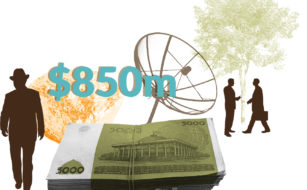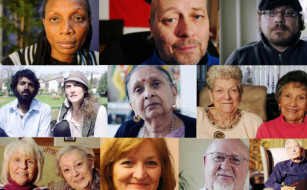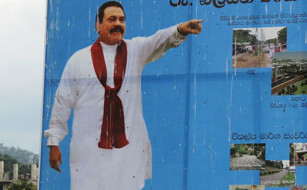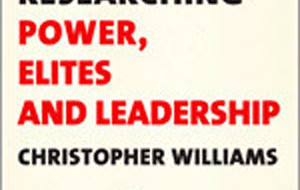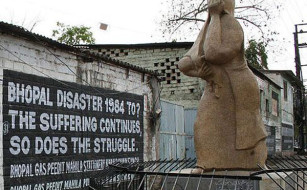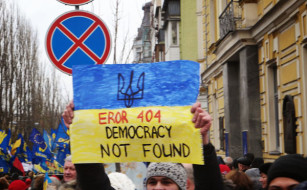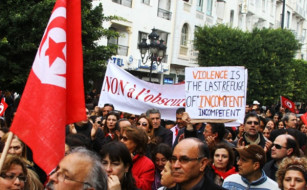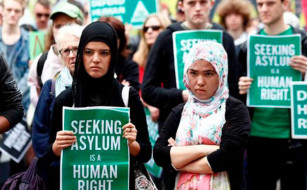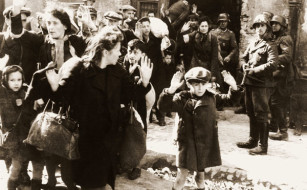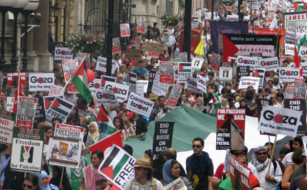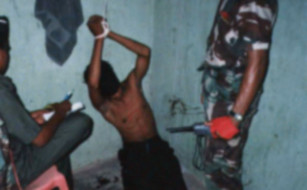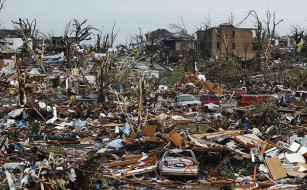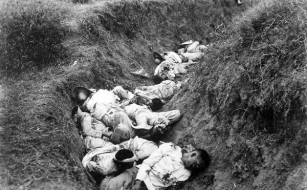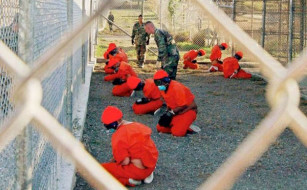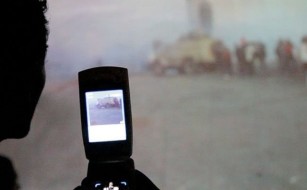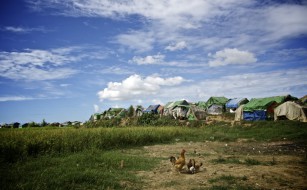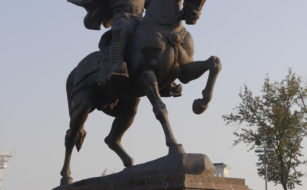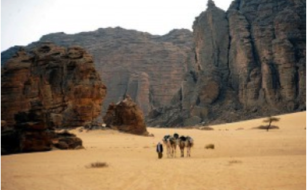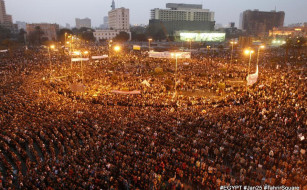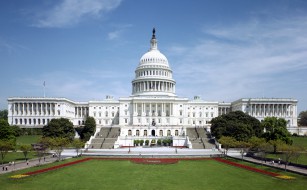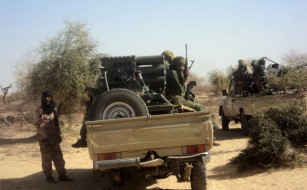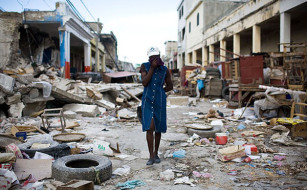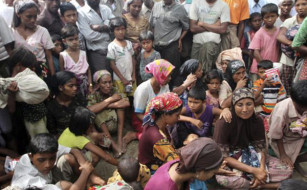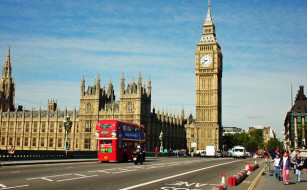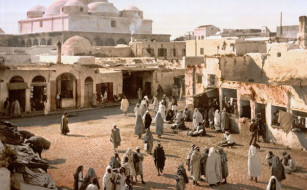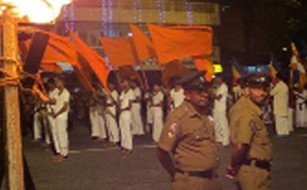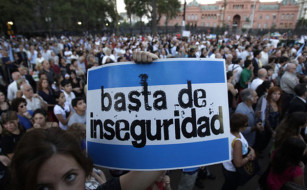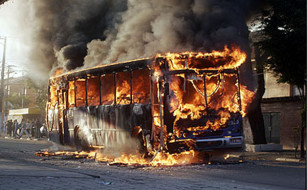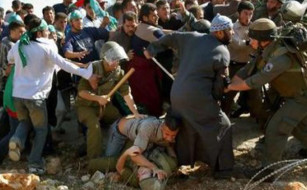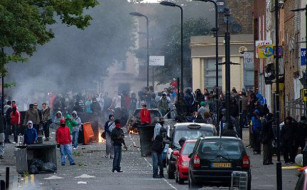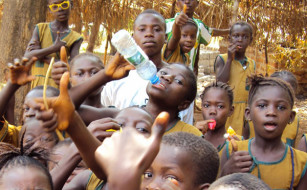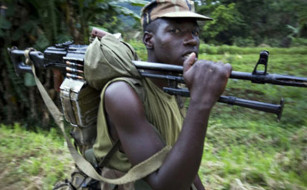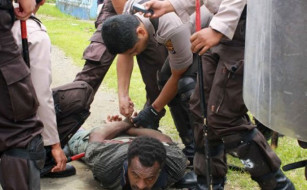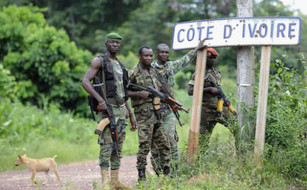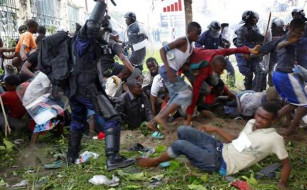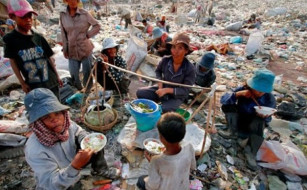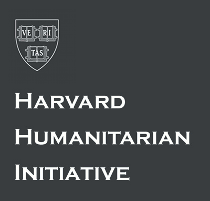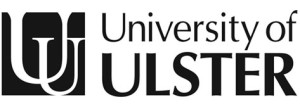Genocide and the Contextual Evidence of Children
November 2010
In June and July 2007, Waging Peace undertook a three-week fact finding mission to Eastern Chad with the aim of collecting testimonies from Darfuri refugees and displaced Chadians. It soon became apparent that many children had witnessed atrocities when Sudanese Government Forces and their allied Janjaweed militia attacked their villages. Whilst rapport-building with the children the WP researcher Anna Schmitt gave the children, aged between six and eighteen years of age, paper and pencils and asked them to describe their dreams for the future and their strongest memories.
The majority of the drawings produced by these children illustrated attacks on their villages with incredibly powerful detail, depicting men being killed, women being shot, beaten and taken prisoner, babies being thrown onto fires and Government of Sudan helicopters and aeroplanes bombing civilians.
During her short field trip to Eastern Chad, Anna Schmitt gathered five hundred drawings from the refugee and displaced children depicting crimes of the Sudanese Government Forces and the Janjaweed militia. The silent child witnesss images of killings, bombing and looting, directly contradicted the Government of Sudans version of events over the years.
In November 2007, the International Criminal Court (ICC) accepted the childrens drawings as contextual evidence of crimes committed in Darfur and in March 2009, the ICC indicted President Umar Hassan Al Bashir on charges of war crimes and murder in Darfur. A second arrest warrant issued by the ICC in July 2010 determined that Al-Bashir bears criminal responsibility for the crime of genocide. This marks the first instance that genocide has been declared whilst still ongoing. The ICC Prosecutor concluded that Al-Bashir had masterminded and implemented a plan to destroy in substantial part the Fur, Masalit and Zaghawa groups, on account of their ethnicity.” In response to Sudanese claims that the death and destruction caused was the product of counterinsurgency operations against rebels, the Prosecutor stated:
the crimes covered in the Application are not the collateral damage of a military campaign. At all times relevant to the Application AL BASHIR specifically and purposefully targeted civilians who were not participants to any conflict with the intent to destroy them, as a group…His alibi was a ‘counterinsurgency’. His intent was genocide.”
The president has reacted to the warrants for his arrest by placing obstacles to the final implementations of the Comprehensive Peace Agreement (CPA).
Despite the arrest warrants, in August 2010 President Al Bashir visited Chad and Kenya, both countries being parties to the Rome Statute that established the ICC. Both governments neglected to arrest the Sudanese President despite their positive obligations, resulting in criticisms levelled against the Chad and Kenyan governments from the court, European governments and human rights organisations. The Kenyan government argued that arresting Bashir could have an adverse effect on the Sudanese peace process. Officials also said Kenya had a duty to the African Union, which instructed its members to defy the ICC and not apprehend Sudan’s president.
Last week the US government renewed a powerful package of economic sanctions against the Sudanese regime in concert with an international arms embargo. This is in stark contrast to the approach of the British government who are currently strengthening its relationship with the regime of the indicted gnocidaire and war criminal, announcing that British relations with Sudan have entered a new epoch. The declaration came as British government officials and business leaders welcomed a high-level Sudanese trade delegation to the UK. The Khartoum delegations visit to Britain was to encourage investment in the country at an Opportunities in Sudan networking event organised by the UK Trade and Investment Authority. On a document handed out at the event, those listed as attending included mining companies, investment banks and security firms. Representatives of major British oil, engineering, agriculture and banking companies who attended the event were told that Sudan was full of “untapped natural resources” and that there was “a lot of money to be made”. An accompanying investors’ guide to Sudan devoted only three lines to the myriad security concerns and insisted that the country had enjoyed twenty years of political stability.
The visit of the Sudanese delegation, the first since the warrants were issued in The Hague, is a clear indicator that Britains new foreign policy prioritises commercial interests over ethical concerns and has outraged human rights organisations. The new minister for Africa, Henry Billingham, has already announced that Britain intends to be a candid friend to the regime in Sudan. The investment booklet issued to attendees sums up the ongoing crisis in Darfur that has killed hundreds of thousands of people and displaced millions more, as well as the North-South arms race ahead of a vote on secession, as small “exceptions” in “peripheral regions”.
The quest for such affable relations with the Sudanese leaves the Coalition partners open to accusations of hypocrisy. While in opposition the Tory party called Darfur the “world’s worst humanitarian crisis” and senior officials including Mr Hague, the current Foreign Secretary, and Andrew Mitchell, now the International Development Secretary, backed the campaign to get UK companies to disinvest from Sudan.
Waging Peace have kindly permitted ISCI to reproduce a sample of the drawings they obtained from the child victims of state crime in Darfur and Eastern Chad, and the accompanying text submitted to the Prosecutor of the ICC:

This boy was 9 when his village in the area of Aishbarra, Darfur, was attacked in 2003 by the Sudanese Government forces and Janjaweed militia. The drawing shows houses burning, villagers being shot and even amputated. The villagers that are attacked are coloured in black, while the attackers have lighter (orange) skin showing the ethnic character of the attacks (ie Arabs attacking black Africans in this case Massalit). In the bottom right of the drawing are two young men, attached by the neck, led away by a janjaweed fighter. These boys could be taken into slavery, or may become child soldiers.
 This young boy was ten when his village in the area of Aishbarra, Darfur, was attacked in 2003 by the Sudanese Government-allied Janjaweed militia. The drawing shows fleeing civilians stopped by the Janjaweed. The civilian men are put in a row to be shot. One man is shot. This method is often used by the Janjaweed as a means of psychological torture, killing some of the men and not others, leaving the women to watch helplessly. One woman and one man are shown with tears falling down their cheeks. In the bottom left hand corner of the drawing, a Janjaweed is searching the mens suitcases for belongings to loot. Once again, the skin colour of the victims and the attackers is different, reflecting the ethnic character of the attacks. The attackers are on worse-back and in machinegun-mounted pick up trucks, both widely used by the Janjaweed militia.
This young boy was ten when his village in the area of Aishbarra, Darfur, was attacked in 2003 by the Sudanese Government-allied Janjaweed militia. The drawing shows fleeing civilians stopped by the Janjaweed. The civilian men are put in a row to be shot. One man is shot. This method is often used by the Janjaweed as a means of psychological torture, killing some of the men and not others, leaving the women to watch helplessly. One woman and one man are shown with tears falling down their cheeks. In the bottom left hand corner of the drawing, a Janjaweed is searching the mens suitcases for belongings to loot. Once again, the skin colour of the victims and the attackers is different, reflecting the ethnic character of the attacks. The attackers are on worse-back and in machinegun-mounted pick up trucks, both widely used by the Janjaweed militia.

This young boy was 11 when his village in the area of Aishbarra, Darfur, was attacked by the Janjaweed in 2003. This drawing depicts a man shot to pieces by the Janjaweed militia.The attackers are on camel and horse backs, clearly identifying them as Janjaweed. They nonetheless are wearing Sudanese Government uniforms (red insignia on the shoulder and army outfits), showing the clear link between the Sudanese Government and the Janjaweed militia, which are armed, trained and equipped by the Sudanese Government. The skin colour of the attackers and the victim is yet again different, the Janjaweed having lighter skin than the attacked civilian.
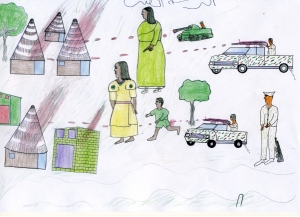
This young boy was 9 when his village in the area of Aishbarra, Darfur, was attacked in 2003 by Sudanese Government forces and Janjaweed militia. In the drawing, two women and a boy are shown fleeing an attack by Janjaweed in two machinegun-mounted pick up trucks and Sudanese forces in a tank. Houses in the village are set ablaze. The Janjaweed and Sudanese forces are shooting at the three civilians and the boy is hit in the leg. The fact that these are women and children who are being shot at clearly shows that the attackers are targeting civilians. The use of a tank in the attack is particularily interesting as the Sudanese Government has consistently denied using such heavy weaponry in Darfur
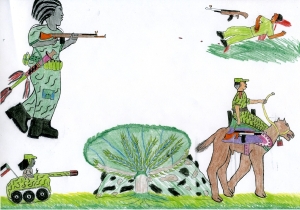 This young boy was 8 when he had to flee his village in Darfur. In this drawing he shows Janjaweed and Sudanese Government troops working together (bottom half of the drawing), and an SLA solider killing a Sudanese Government soldier (top half of the drawing). Interestingly, a Sudanese flag is drawn on the tank, clearly identifying it as from the Sudanese Government.
This young boy was 8 when he had to flee his village in Darfur. In this drawing he shows Janjaweed and Sudanese Government troops working together (bottom half of the drawing), and an SLA solider killing a Sudanese Government soldier (top half of the drawing). Interestingly, a Sudanese flag is drawn on the tank, clearly identifying it as from the Sudanese Government.
.jpg)
.jpg)
.jpg) This young boy was 17 when his village was attacked in 2003. In this three panel drawing, he describes the attacker getting ready, the attack of the village (burning houses, dead bodies) and the displacement caused by the attack.
This young boy was 17 when his village was attacked in 2003. In this three panel drawing, he describes the attacker getting ready, the attack of the village (burning houses, dead bodies) and the displacement caused by the attack.
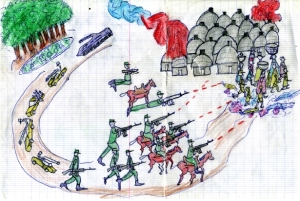 This boy was 8 when his village in Darfur was attacked in 2004. His drawing describes this attack, where Janjaweed forces (drawn on horse backs) and Sudanese forces (in vehicles and tanks) worked together to burn his village, kill many civilians (shown lying on the ground) and lead to the displacement of the survivors).
This boy was 8 when his village in Darfur was attacked in 2004. His drawing describes this attack, where Janjaweed forces (drawn on horse backs) and Sudanese forces (in vehicles and tanks) worked together to burn his village, kill many civilians (shown lying on the ground) and lead to the displacement of the survivors).
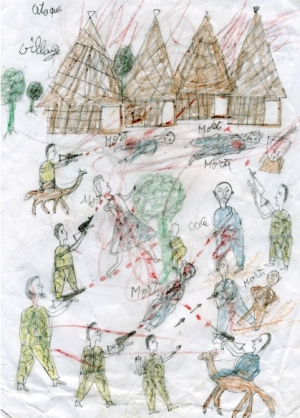
This picture was drawn by a young Chadian by in a camp for displaced persons in Eastern Chad. His drawing describes the attack on his vllage by Janjaweed militias from Sudan. On the top left hand corner of the drawing is written ataque village (French for attack of the village). The attackers, wearing military uniforms and on camels are shooting civilians with machine guns and burning their houses. Bullets are coming from all over. Next to each civilian that is shot is the word Morts which is the plural of dead in French.

This young boy was 8 when his village in Darfur was attacked in 2003 by Janjaweed and Sudanese armed forces. He is now 12 and living in a refugee camp in Eastern Chad. In this drawing the attackers, on camel and horse backs and in armed vehicles, are setting the houses on fire and shooting at civilians from all corners (note how the bullets are crossing each others paths). The villagers are also fighting back with spears and arrow, while the Janjaweed and Sudanese forces are attacking them with machine guns. The skin colour of the attackers is lighter than that of the victims, clearly denoting the ethnic aspect of the attacks.
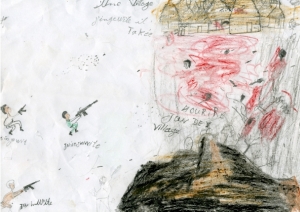 This picture was drawn by a young Chadian boy in a camp for displaced persons in Eastern Chad. His drawing describes the attack on his village by Janjaweed militias from Sudan. The whole village is set on fire and there are body parts scattered in the right of the drawing. Next to the body parts, the boy wrote Mourire Jan de village (Mourir gens du village) which is the French for the people from the village are killed. Under the attackers in the left of the picture is written janjinwite, clearly identifying the attackers as the Sudanese-Government allied Janjaweed forces.
This picture was drawn by a young Chadian boy in a camp for displaced persons in Eastern Chad. His drawing describes the attack on his village by Janjaweed militias from Sudan. The whole village is set on fire and there are body parts scattered in the right of the drawing. Next to the body parts, the boy wrote Mourire Jan de village (Mourir gens du village) which is the French for the people from the village are killed. Under the attackers in the left of the picture is written janjinwite, clearly identifying the attackers as the Sudanese-Government allied Janjaweed forces.
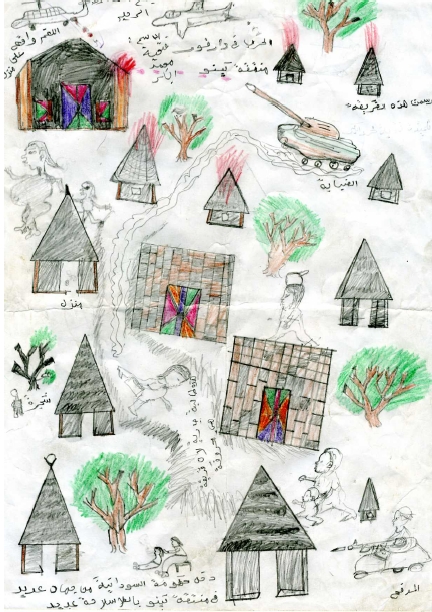
This young girl was 11 when her village in Darfur was attacked in 2004. The drawing, depicting an attack by the Sudanese government and the janjaweed forces, contains small explanations within the drawing. On the bottom left, she writes: The Sudanese government soldiers entered the village on camels. On the bottom write, under a tank: heavy artillery. Under the plane, she writes the airplane bombs are dropped over the house.
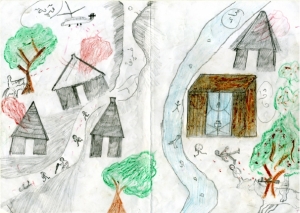
This young boy was 15 when his village in Darfur was attacked by Janjaweed and Sudanese armed forces in 2004. Houses are set on fire and civilians are shot dead and thrown into the river. Behind the drawing, he has written Look at these pictures carefully, and you will see what happened in Darfur. Thank you.
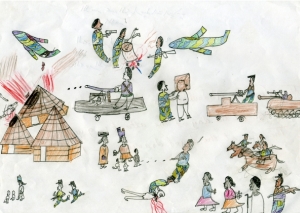
This boy was 9 when his village in Darfur was attacked by Sudanese Government forces and Janjaweed militias in 2003. This drawing describes in detail some of the exactions committed by the Janjaweed (on foot and on horses) and the Sudanese forces (in tanks, machine gun mounted vehicles and planes). At the top of the picture a boy is thrown into a fire. In the middle, a man has a bag over his head before being shot. A Soldier in a technical shoots a civilian. At the bottom, a soldier appears to be cutting a mans head off. Women, with hands tied behind them are being marched off at gun point. A woman with her possessions on her head leaves with her 2 children, pursued by 2 soldiers. A Government plane is bombing the village and setting the houses on fire.
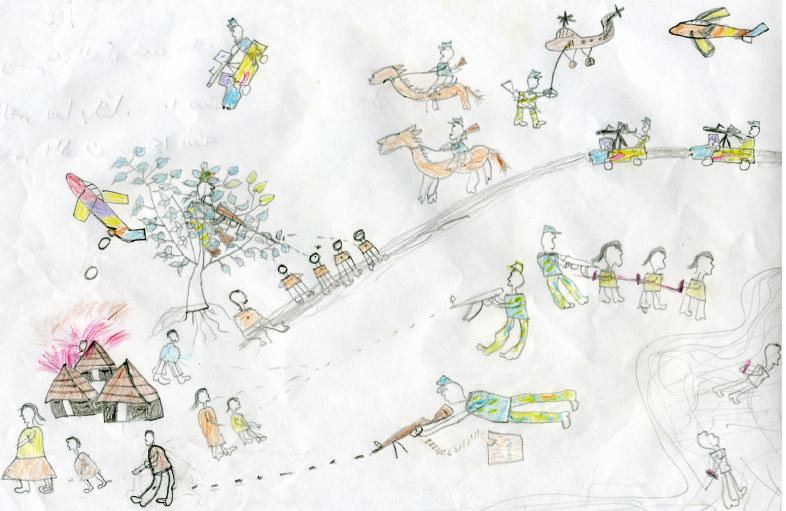 The young boy was 10 when his village in Darfur was attacked in 2003. Sudanese Government forces in pick up trucks, helicopters and airplanes and Janjaweed militias on horsebacks are seen attacking a village.In the left of the drawing, an antonov is bombing the village, putting fire to the huts. Sudanese forces on the ground and perched in trees are targeting young women, men and children. Three women are tied up and taken away by a Sudanese soldier while men are killed and thrown into the valley.
The young boy was 10 when his village in Darfur was attacked in 2003. Sudanese Government forces in pick up trucks, helicopters and airplanes and Janjaweed militias on horsebacks are seen attacking a village.In the left of the drawing, an antonov is bombing the village, putting fire to the huts. Sudanese forces on the ground and perched in trees are targeting young women, men and children. Three women are tied up and taken away by a Sudanese soldier while men are killed and thrown into the valley.
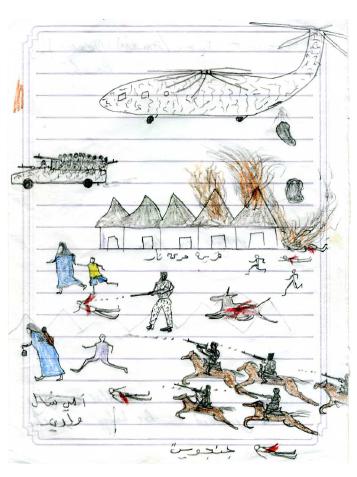 This young boy describes the attack by Sudanese Government forces and Janjaweed militias on his village in Darfur. In the top of the drawing, a Sudanese helicopter is shown bombing the village, setting houses on fire and killing civilians and a donkey. Under the houses, the young boy wrote village on fire. A Sudanese soldier and Janjaweed forces are shooting and killing at fleeing civilians. Under the drawing of armed men on horseback, is written Janjaweed.
This young boy describes the attack by Sudanese Government forces and Janjaweed militias on his village in Darfur. In the top of the drawing, a Sudanese helicopter is shown bombing the village, setting houses on fire and killing civilians and a donkey. Under the houses, the young boy wrote village on fire. A Sudanese soldier and Janjaweed forces are shooting and killing at fleeing civilians. Under the drawing of armed men on horseback, is written Janjaweed.
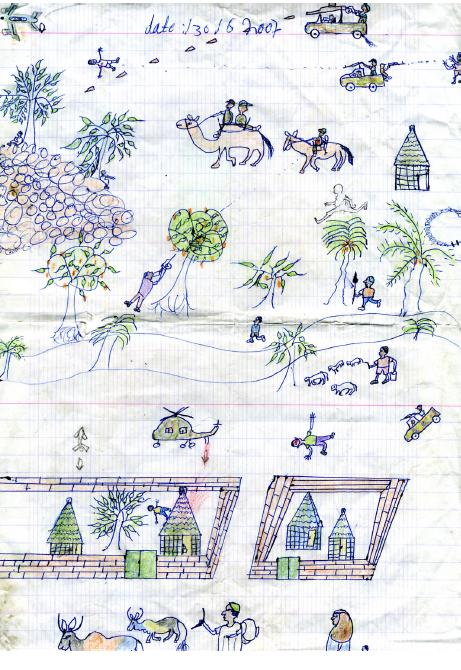
In this drawing, a young girl from Darfur shows the peaceful life in her village being disrupted by a violent attack by Sudanese Government forces and the Janjaweed militia. Some villagers are seen herding cattle and sheep or sitting under trees. But this sense of calm is contrasted by Sudanese airplanes and helicopters bombing the village and setting fire to the houses. Government forces in pick up trucks and Janjaweed on horse and camel backs are shooting at civilians.

This drawing clearly depicts an attack by Sudanese government forces on a village in Darfur. Three airplanes and a helicopter with Sudanese Government markings are hovering above the village, with one of the planes shown droppin a bomb. The huts are on fire as villagers are seen fleeing.
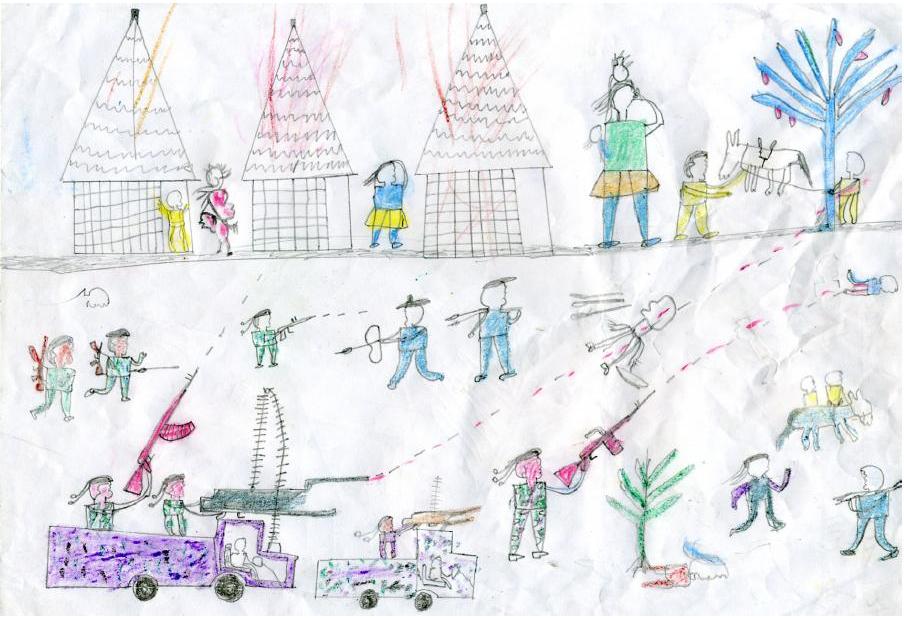
This drawing describes an attack by Sudanese Government forces on the village in Eastern Chad. Sudanese armed forces, identifiable by their berets and uniforms, arrive in the village on machinegun mounted pick up trucks and by foot. They shoot at the fleeing population that only has arrows to protect itself, while the houses are set alight.
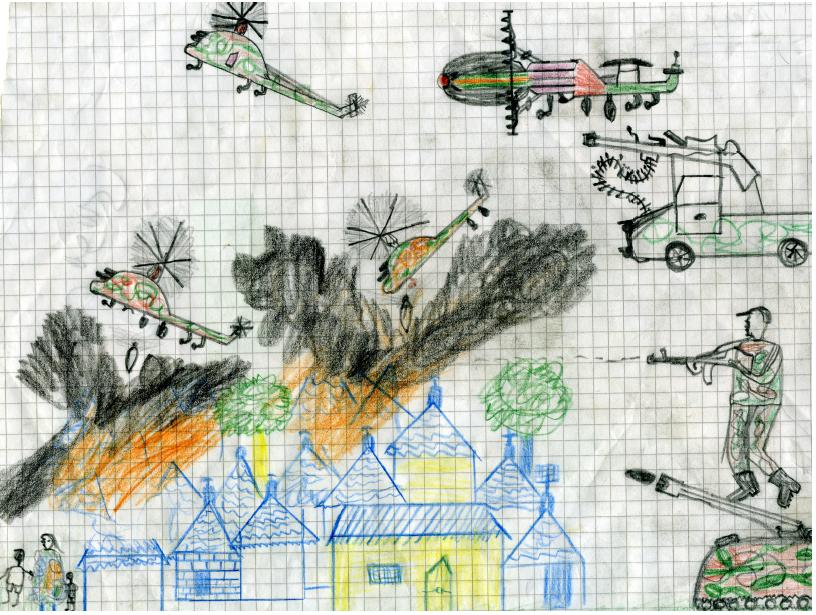
This young boy drew an attack by Sudanese Government forces on his village in Darfur. Sudanese soldiers on foot, in elaborate pick up trucks and in tanks shoot at the village while three helicopters set fire to the houses. A mother and her two children are seen fleeing.
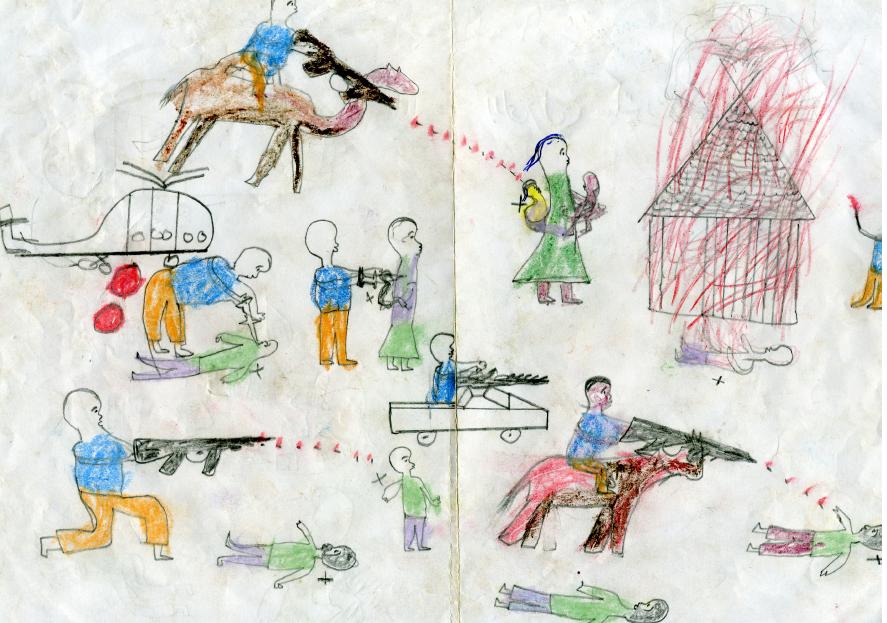
This young girl describes an attack on her village in Darfur. In this drawing the attackers (Sudanese army and Janjaweed militia) are drawn with a blue top and orange trousers, while the targeted civilians are dressed in green and purple. A Sudanese helicopter drops bombs on the village while armed men on horses, camels and by foot are shown shooting civilians, stabbing them and setting fire to their homes. Next to each dead person is a cross.


